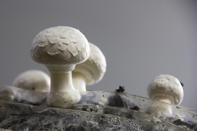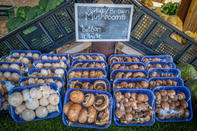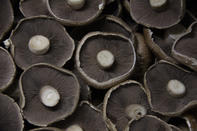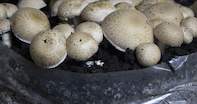Mushrooms are economical and healthy and its addition to dishes such as omelettes and stews will add flavour and nutritional value to a diet.

In South Africa, the most common way of using mushrooms is cooked (from fresh). Mushrooms are generally used in dishes such as omelettes, risotto, soups and mushrooms sauces combined with steak, pasta and vegetables. Mushrooms can also be eaten raw in salads and used as medicine.
The article ‘Mushroom Products’ gives more information on mushroom-related products.
Are Mushrooms Healthy?
Mushrooms contain fibre, protein, vitamins, minerals and antioxidants. The antioxidants in mushrooms are selenium, vitamin C, choline as well as the sulfur-containing amino acid: ergothioneine which also protects against oxidative stress.
Button mushrooms are a source of eight different vitamins and six different minerals. These include copper, selenium, potassium, manganese, zinc and phosphorus as well as the vitamins B1, B2, B3, vitamin C and pantothenic acid.
Hungary, a country with a selenium deficiency, has studied the process of enriching button mushrooms with selenium by treating the growing substrate (compost) with different selenium compounds. As an antioxidant, selenium plays a role in the prevention of tumours and reduces the side effects of cancer treatments.
Mushrooms and Vitamin D

Vitamin D is needed to boost the immune system and is needed for healthy bones and protects the body against osteoporosis, high blood pressure, and inflammation.
Although mushrooms grow in conditions where there is no natural sunlight, it can be a valuable source of vitamin D. Mushrooms contain ergosterol, a plant sterol that converts to vitamin D2 when exposed to ultraviolet light. Research undertaken at the Sydney Medical School in Australia has found that when a 100 g portion of (raw) button mushrooms are left in midday sunlight for an hour, it contained 10 mg of vitamin D, the daily recommended allowance of vitamin D for adults. Brown portabella (or portobello) mushrooms take about two hours to reach a vitamin D level of 10 mg.
Eating Mushrooms

Mushrooms come in various forms - fresh, canned, dried, powdered, frozen - and depending on the strain, can be eaten raw, cooked, rehydrated from its dried form and also taken as a medicine in the forms of capsules and powders.
Mushrooms retain more nutrients when cooked for a shorter time and it was found that grilling or cooking mushrooms in a microwave increase the antioxidant properties compared to mushrooms fried in a pan.
Meat and Mushrooms
Mushrooms are often combined with other ingredients or added to dishes to increase the umami (savoury flavour) of dishes.
There is a trend to blend mushrooms and meat to reduce the kilojoule content and increase the flavour and nutrition of a meat-based dish. Research showed that a 50:50 blend of mushrooms and meat (minced beef, chicken, lamb and even fish) will decrease the intake of saturated fat and increase the nutritional value of the meal without losing the meaty flavour.
Mushrooms as Medicine

Apart from food, mushrooms are also used for the treatment of various ailments and have been used for thousands of years as a traditional medicine in the East.
There are over 2 000 identified species of edible and/or medicinal mushrooms with much research being done on their benefits and medicinal value. What follows is a brief description thereof.
Ongoing research is indicating that certain varieties of mushrooms play a role in the prevention of many age-associated diseases such as Alzheimer's and Parkinson's. Research focuses on the mushroom types that will improve memory and thought processes but to date, the turkey tail mushroom is the most extensively researched mushroom. Medicinal properties such as its use to treat infections (including HIV and herpes), to improve the immune function in breast cancer patients and its benefits in relieving chronic fatigue, continue to be investigated.
The other medicinal properties of mushrooms are: antioxidant, anti-diabetic, anti-tumour, anti-cancer, immunomodulatory and anti-allergic. Some of the mushrooms credited with success against cancer are the Agaricus species (brown and button mushroom), the wild mushroom - bay bolete, enoki, Lactarius mushrooms (‘milkcaps’), the species of brightly coloured Russula genus and many more.
Not all the beneficial mushrooms are edible and extreme care must be taken when foraging for any wild mushroom. It is advised to consult a mushroom specialist or health practitioner before ingesting any foraged mushroom, whether for culinary or medicinal purposes.
By Marinda Louw